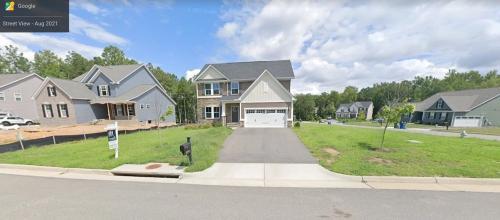
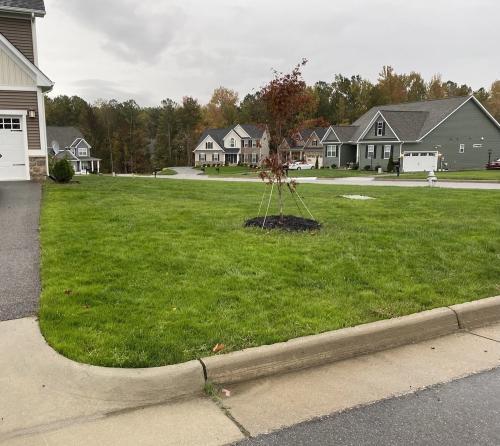
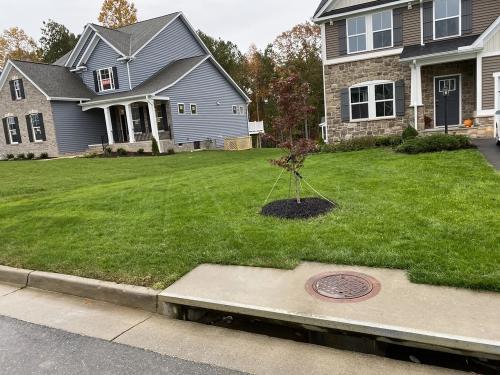
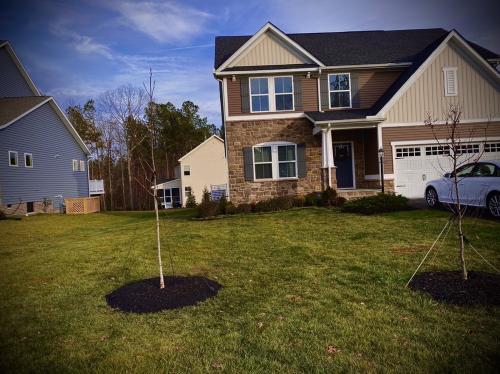

stone said:You certainly need trees...
I usually try to plant to suit multiple goals.
Like say I want fast shade, and want to see butterflies...
In which case I would plant poplar for tiger swallowtails, and hackberry for tons of other butterflies as well as berries for birds.
And, red mulberry attracts birds, not just for the berries, but also for all the caterpillars to feed their babies.
Then, at my house... I need trees that produce wood that won't rot when I cut down the trees...
Trees like black locust, honey locust, cedar, osage orange, black walnut...
And then... everybody likes fruit...
Unfortunately, most of my fruit trees got sick from the diseases associated with our humidity.
I do have a pear tree that hangs in there in spite of fire blight...
and persimmons and paw paws and the fore mentioned mulberry are growing ok...
of course, there are nice shrubs... like red buckeye, and beauty berry, tall blue berry, wax myrtle...
There's going to be plenty of great plants that you can grow instead of that useless patch of turf.
NMoasis said:Ceriano, there is an issue with planting trees in lawns that you might want to consider:
Grass (roots) and trees (roots) require completely different watering methods. Subjecting trees, especially saplings, to the frequent and shallow watering that grass requires causes the roots to travel to the surface, making the trees less stable and less able to withstand periods of drought, and eventually causes the roots to become exposed and susceptible to lawnmower damage. To encourage the development of strong roots, young trees need regular (but less frequent than lawn) deep irrigation for their first year, at least.
That said, I'm a Westerner and I don't know what your rainfall is like ... do you even have to water your lawn? Does the rainfall soak the soil several feet down?
DaisyI said:Anothe problem with trees in lawns is lawn fertilizer. Its very high in nitrogen, something most trees can't handle. It causes them to grow too fast and thus develop weak structure. They don't live as long either. Using a 'weed and feed' product comes with its own risk as trees are broad leaf and weed and feed is not very specific about what broad leafed plants it will kill.
Putting big bare rings around trees isn't really successful as tree roots travel sometimes hundreds of feet from the trunk. If you plan to have a lush green lawn, you may want to rethink the yard full of trees.
CalPolygardener said:Redbud - any of the many varieties
Chionanthus
Crepe Myrtle - common but colorful
Chinese Tallow Tree (Sapium sebiferum)
Sour Gum (Nyssa sylvatica)
Ginkgo
Several are invasive in some areas, check to see if they are in your area.
ViburnumValley said:ceriano could support the best recommendations by describing what cannot be seen in the provided images: what are conditions below ground?
Some mention was made on another post, but I gather not everyone here has already visited there. Speak to the soil quality, or - better - show us what an open hole looks like!
Is this the driven sand of a seaside resort? The 11 - 12' deep Maury silt loam of the famed central Kentucky Bluegrass thoroughbred horse farm region? Caliche, like in (I think) Texas or New Mexico? Perhaps it is anaerobic gray hydric soils from a wetland?
I suspect (since a Streetview image showed new construction next door) that whatever topsoil the original site came with is long gone. There is probably a poorer draining B horizon subsoil with fresh sod on top, which means that great plant selections might have to take a reality check back seat to very tolerant plant selections. This doesn't mean one can't grow anything, and it doesn't mean one can't go out on a limb (!) with some wishful gardening thinking.
It does mean one should have clear-eyed expectations, and know what the chances are that a Cornus florida will just grow with abandon - despite it being a perfectly at-home native species in this part of Virginia. Local plants are going to do fine in unadulterated local conditions, but severely disturbed/compacted/irretrievably altered conditions require a different approach.
I see that I've become even more pessimistic than my predecessors - without meaning to. I would consider this wide open site to be more akin to a new highway cut - a pioneer species landscape. Around here, that means Juniperus virginiana, Rhus glabra, and Robinia pseudoacacia. I think you will likely be able to do somewhat better than that, but knowing what you have to work with and thinking about species that actually want to grow in those conditions can often lead to satisfaction on the first try - and certainly a LOT less effort on your part.
**Liquidambar styraciflua clones
**Nyssa sylvatica (as mentioned, with many exceptional clones like 'Red Rage')
**Taxodium distichum/Taxodium ascendens/Metasequoia glyptostroboides
**Quercus michauxii, Quercus phellos, Quercus lyrata
**Magnolia virginiana and its many selections
**Betula nigra
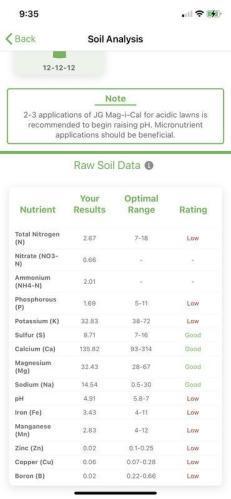
ViburnumValley said:ceriano could support the best recommendations by describing what cannot be seen in the provided images: what are conditions below ground?
Some mention was made on another post, but I gather not everyone here has already visited there. Speak to the soil quality, or - better - show us what an open hole looks like!
Is this the driven sand of a seaside resort? The 11 - 12' deep Maury silt loam of the famed central Kentucky Bluegrass thoroughbred horse farm region? Caliche, like in (I think) Texas or New Mexico? Perhaps it is anaerobic gray hydric soils from a wetland?
I suspect (since a Streetview image showed new construction next door) that whatever topsoil the original site came with is long gone. There is probably a poorer draining B horizon subsoil with fresh sod on top, which means that great plant selections might have to take a reality check back seat to very tolerant plant selections. This doesn't mean one can't grow anything, and it doesn't mean one can't go out on a limb (!) with some wishful gardening thinking.
It does mean one should have clear-eyed expectations, and know what the chances are that a Cornus florida will just grow with abandon - despite it being a perfectly at-home native species in this part of Virginia. Local plants are going to do fine in unadulterated local conditions, but severely disturbed/compacted/irretrievably altered conditions require a different approach.
I see that I've become even more pessimistic than my predecessors - without meaning to. I would consider this wide open site to be more akin to a new highway cut - a pioneer species landscape. Around here, that means Juniperus virginiana, Rhus glabra, and Robinia pseudoacacia. I think you will likely be able to do somewhat better than that, but knowing what you have to work with and thinking about species that actually want to grow in those conditions can often lead to satisfaction on the first try - and certainly a LOT less effort on your part.
**Liquidambar styraciflua clones
**Nyssa sylvatica (as mentioned, with many exceptional clones like 'Red Rage')
**Taxodium distichum/Taxodium ascendens/Metasequoia glyptostroboides
**Quercus michauxii, Quercus phellos, Quercus lyrata
**Magnolia virginiana and its many selections
**Betula nigra

ViburnumValley said:
I suspect (since a Streetview image showed new construction next door) that whatever topsoil the original site came with is long gone. There is probably a poorer draining B horizon subsoil with fresh sod on top, which means that great plant selections might have to take a reality check back seat to very tolerant plant selections. This doesn't mean one can't grow anything, and it doesn't mean one can't go out on a limb (!) with some wishful gardening thinking.
stone said:
Those new construction sites tend to have compacted soils.
You say that you have red clay... which in truth is about the best thing you could ask for... that red clay is the best soil in Georgia!
But the fact that your yard has had heavy equipment on it recently, means that the soil is horizontal... dig a hole fill with water... does it ever drain?
Digging through all those horizontal layers until reaching a level below the compaction is a labour worthy of Atlas...
So... only planting a few trees in hope that they all grow... seems fairly unrealistic.
Far more reasonable to plant a lot of trees with the intention of thinning... should it ever become necessary.
Of course... this plan may not be affordable if purchasing expensive cultivars from the local nursery... far more practical would be digging a seedling bed and collecting seeds from the attractive trees in the neighborhood... sowing those and setting them out after a few years.
stone said:In my experience... there is always compaction with new construction.
The soil that the sod people bring in is usually a thin layer in my area... and... they spread it with more heavy equipment... making things worse... never better.
They do market plows to break up that compaction... but the equipment required for operation wouldn't fit on your plot.
I suspect that your expensive trees are going to prove extremely slow to grow... without some backbreaking labour to repair the soil.